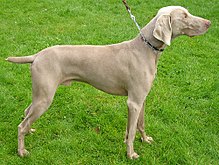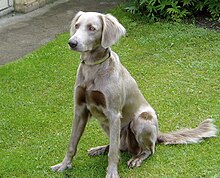Weimaraner
The Weimaraneris a dog that was originally bred for hunting in the early 19th century. Early Weimaraners were used by royalty for hunting large game such as boar, bear, and deer. As the popularity of large game hunting began to decline, Weimaraners were used for hunting smaller animals like fowl, rabbits, and foxes. Weimaraners are great water dogs as evidenced by their webbed toes.
The Weimaraner is an all purpose gun dog. The name comes from the Grand Duke of Saxe-Weimar-Eisenach, Karl August, whose court, based in the city of Weimar (now in modern day Germany), enjoyed hunting.
History
Today's breed standards are alleged to have developed in the late 18th and early 19th century, although dogs having very similar features to the Weimaraner have supposedly been traced as far back as 13th century in the court of Louis IX of France. One theory is that the ancestor is the St. Hubert Hound (also known as the Bloodhound and Sleuth Hound)[verification needed]. Though these dogs are black, they can produce a grey dog when bred. Like the Vizsla at the time, the breed was created exclusively for the nobility and alike. The aim was to create a noble-looking, reliable gundog. As ownership was restricted and natural instinct, the breed was highly prized and lived with the family. This was unusual, as during this period, hunting dogs were kept in kennels in packs. This has resulted in a dog that needs to be near humans and that quickly deteriorates when kenneled. The Weimaraner was an all purpose family dog, capable of guarding the home, hunting with the family, and of course, being loving and loyal towards children.
Originally, Germany was possessive of its skilled all-purpose gundog. Some of the earliest weimaraners, prior to being sent to America for breeding, were sterilized in order for America not to popularize their special breed. But starting in the late 19th century the breed became increasingly common throughout Europe and the United States. Although slower than many other gundogs, such as Pointers, the Weimaraner is thorough and this made it a welcome addition to the sportsman's household. The breed's happy, lively temperament has endeared it to families. With the rise in popularity, some changes have been made to the breed. Both in Britain and America (where the breed remains popular) breeders have taken care to breed to a standard.
Appearance
The Weimaraner is athletic in appearance. Traditionally, the tail is docked. In countries where this is still carried out, the docked tail should measure approximately 6 inches in the adult dog, and this is part of the American Kennel Club breed standard. Tail docking is illegal in several countries, and in these countries the breed is shown with an entire tail. The British Kennel Club breed standard describes a tail reaching to the hocks and carried below the level of back when relaxed, and the German breed club standard calls for a full tail that is strong and well coated, which can be carried above the line of the back when the dog is working.
The eyes of the Weimaraner may be light amber, grey, or blue-grey.
Coat and color
This breed's short coat and its unusual eyes give it a regal appearance different from any other breed. The coat is extremely low maintenance, short, hard, and smooth to the touch, and may range from charcoal-blue to mouse-grey to silver-grey or even blue-gray. Where the fur is thin or non-existent, inside the ears or on the lips, for example, the skin should be a pinkish tone rather than white or black. This breed does not have an undercoat, so extreme cold should be avoided. While their coat is short, this breed does shed.
In November 2009 and January 1, 2010 the United Kennel Club (UKi) removed the disqualification from both Blue and Longhair Weimaraners. A black coat remains an automatic disqualification, though a small white marking in the chest area only is permitted. Dogs with blue coats are disqualified from conformation/show competition,[1] but are recognized as purebred Weimaraners by the AKC. There is another incidental variety, described as having the 'mark of the hound', where the dog is the usual grey colour but with faint tan markings (similar to Doberman). It's said that early in the breed this was a common colour that was selectively bred out.
A long-haired variety is recognized by most kennel clubs around the world except in the American Kennel Club. The long-haired Weimaraner has a silky coat, with an undocked, feathered tail. The gene is recessive, so breeding will produce some long-haired puppies only if both parents carry the trait.
Size
According to the AKC standard, the male Weimaraner stands between 25 and 27 inches (63–68 cm) at the withers.
Females are between 23 and 25 inches (58–63 cm). Of course, there are many dogs taller or shorter than the breed standard. The breed is not heavy for its height, and males normally weigh roughly 70–80 pounds (32–36 kg). Females are generally between 55-70 lbs (25–32 kg). A Weimaraner should give the appearance of a muscular, athletic dog.
Temperament
From adolescence, a Weimaraner requires extensive exercise in keeping with an energetic hunting dog breed prized for their physical endurance and stamina. No walk is too far, and they will appreciate games and play in addition. An active owner is more likely to provide the vigorous exercising, games, or running that this breed requires. Weimaraners are high-energy and often wear out their owners, requiring appropriate training to learn how to calm them and to help them learn to control their behavior. Owners need patience and consistent, firm yet kind training, as this breed is particularly rambunctious during the first year and a half of its life. But, even after that year and a half of a rambunctious puppyhood, they still remain hyper as ever, even when they are settling into old age. Like many breeds, untrained and unconfined young dogs often create their own fun when left alone, such as chewing house quarters and furniture. Thus, many that are abandoned have behavioral issues as a result of isolation and inadequate exercise.
Weimaraners are generally good with children, but may not be appropriate for smaller children due to their tendency to knock them down in the course of play. They also may knock over elderly people or children by accident. Early training to sit through positive reinforcement is critical to prevent jumping in the future.
The Weimaraner is a hunting dog and therefore has a strong, instinctive prey drive. Weimaraners will sometimes tolerate cats, but usually not, they tend to still engage in their hunting abilities no matter how long they've known a particular cat, and in many time will chase and frequently kill almost any small animal that enters their garden or backyard. In rural areas, most Weimaraners will not hesitate to chase deer or sheep.
This breed of dog tends to be very stubborn. However, with good training, these instincts can be curtailed to some degree. A properly trained Weimaraner is a companion that will never leave its master's side. While they do thrive on play and exercise, Weimaraners are well suited to an indoor, family lifestyle, and generally are not suited for life in a kennel because of their strong desire to be with their owner and family.
As a Hunting Dog
Weimaraners have an excessive amount of energy that requires a good outlet. Weimaraners are well-rounded hunting dogs that excel at hunting, tracking, pointing, and retrieving both on land and in the water. The Weimaraner is a very people-oriented breed. They have a very strong desire to work and live with their owners, making the breed a good choice for the novice hunter. It requires a gentle touch when training to hunt and it often learns best from a seasoned hunting dog.
 | ||||||||||||||||
| The Weimaraner's coat colour led to its nickname of "the Grey Ghost". | ||||||||||||||||
| Other names | Weimaraner Vorstehhund | |||||||||||||||
|---|---|---|---|---|---|---|---|---|---|---|---|---|---|---|---|---|
| Nicknames | Weim Grey Ghost | |||||||||||||||
| Country of origin | Germany | |||||||||||||||
| ||||||||||||||||
| ||||||||||||||||




No comments:
Post a Comment